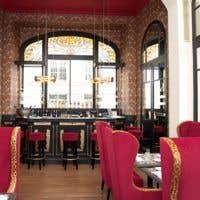This article was also published in the Financial Times.
La Table des Anges in the shadow of Montmartre and Les Climats just behind the Musée d'Orsay in Paris could not be more different to the passer by.
The former boasts four tables on a narrow pavement while that outside Les Climats is home to a tall, well-dressed doorman who stands next to a frame containing its menu and a brief history of its Art Deco interior. But both, I was to discover, are the happy confluence of determined restaurateurs and talented chefs, albeit from very different backgrounds.
The steep rue des Martyrs is home to numerous food shops, cafes and restaurants, most of them offering good-value set menus. But when I first saw the blackboards outside La Table des Anges, I was intrigued. (The photo below is taken from the restaurant's website.) The prices seemed very reasonable but the
 dishes were far more ambitious than the norm. My appetite was certainly whetted by the offer of a langoustine bisque at just 12 euros. Was there, I wondered, a budding young chef at the stoves?
dishes were far more ambitious than the norm. My appetite was certainly whetted by the offer of a langoustine bisque at just 12 euros. Was there, I wondered, a budding young chef at the stoves? My first visit took place at 9.45 pm one wet evening at the end of a 15-minute walk from the Gare du Nord and I could not have been made more welcome. A plate of charcuterie was put in front of me as I sat down; my first course, a light, frothy scallop soup, and the beef cheeks braised in Cahors that followed displayed a range of culinary talents; and my glass of white wine was topped up by Martial, the genial waiter, so that I had something to accompany the slices of three different goats cheeses. My bill was 36 euros.
We returned on Saturday lunch to try what proved to be an excellent langoustine bisque (made from Scottish langoustines) and also their great-value 16-euro two-course menu. This included a bowl of creamy salt cod; a slightly hefty quenelle de brochette, the large, fish mousse that was once a permanent feature on every French bistro menu; a crème brûlée whose cream had been laced with pistachios; and the fruit from a pina colada reworked into quite a complex dessert alongside coconut ice cream.
The tall, relaxed figure who emerged from behind the bar with our bill for two for 43.50 euros including wine turned out to be the owner, Jacques-Henri Strauss, who gave up his former career financing hotels for others to follow a dream of opening his own restaurant.
His courage was rewarded nine months ago when he was joined by Yan Duranceau, a chef who learnt his trade in the grand kitchens of Le Grand Vefour, the Plaza Athénée and Taillevent but who now finds more pleasure in coaxing the best flavours out of less expensive ingredients. The blackboards, which I believe can be the most useful indication of freshness and change emanating from any kitchen, are certainly the key to the best that this aptly named restaurant has to offer.
The key to Les Climats (photographed above left by Christine Tamalet) lies in its name. In Burgundy a climat is an individual vineyard, a particular plot of land defined by its position, soil and mesoclimate. This is an association which restaurateurs Carole Colin and Denis Jamet have taken as a pretext for creating a list of over 3,000 wines from 300 different winemakers exclusively from this particularly captivating region.
The realisation of this highly ambitious goal – burgundy is produced only in small quantities and the list is the consequence of one or other of the partners travelling there every week to cajole a small allocation out of their producers – has been accentuated by the restaurateurs' discovery of an equally distinguished setting. This early-20th-century interior now houses a bar; a rather stiff dining room that leads into a more relaxed conservatory that in turn overlooks an enclosed garden that will be a lovely place to sit out in, when the sun allows; and two, large temperature-controlled walk-in wine chambers.
On 13 April, its third evening, our table of six comprised the majority of the customers and Les Climats had not yet become more than the sum of its parts. But the parts are promising.
Its wine list is excellent and I managed to spend 192 euros of my 632-euro bill on three delicious wines: a Bourgogne Blanc from Benjamin Leroux (34 euros), and two reds, a Vosne Romanée from Cecile Tremblay 2009 (96 euros) and a Fixin, Clos de la Perrière, from Dom Joliet 2008 (62 euros).
The balance went on a variety of stylish dishes from Vietnamese-born chef Phan Chi Tam. These began with a plate of gougères, the savoury cheese puffs that are frequently served at the end of a wine tasting in Burgundy, but this was in fact the only culinary nod to the region. The rest – sea bream carpaccio that lacked that vital squeeze of lemon, monkfish with an Asian broth, a rack of veal with aubergines and five very good desserts – were modern in presentation, fresh on the palate and excellent accompaniments to the wines.
France's leading politicians, housed not that far away from Les Climats, have shown little support for its wine over the past decade. Today, Burgundy's winemakers, and anyone who enjoys drinking it, have a new champion.
La Table des Anges 66 rue des Martyrs, Paris 75009; tel + 33 1 55 32 24 89 www.latabledesanges.fr Closed Sunday and Monday.
Les Climats 41 rue de Lille, Paris 75007; tel +33 1 58 62 10 08
www.lesclimats.fr Open 7 days.

